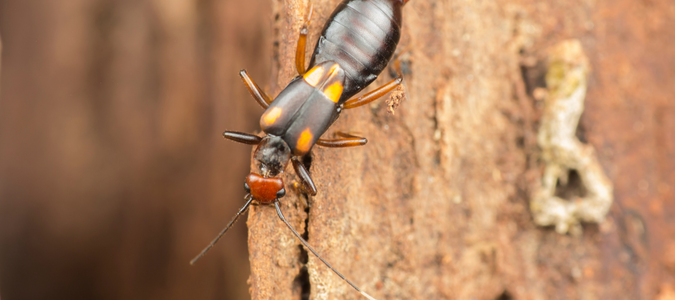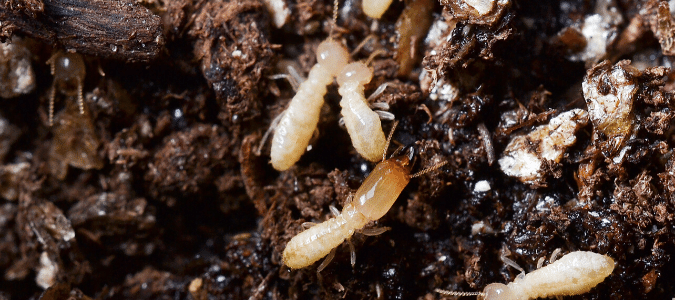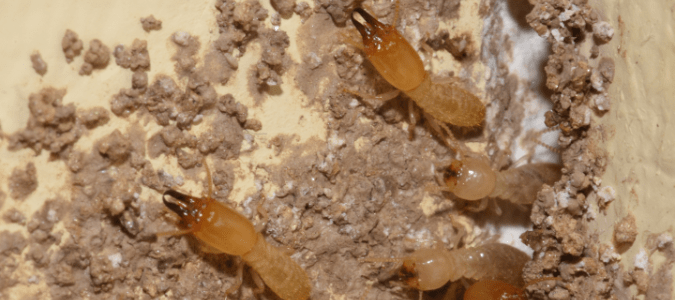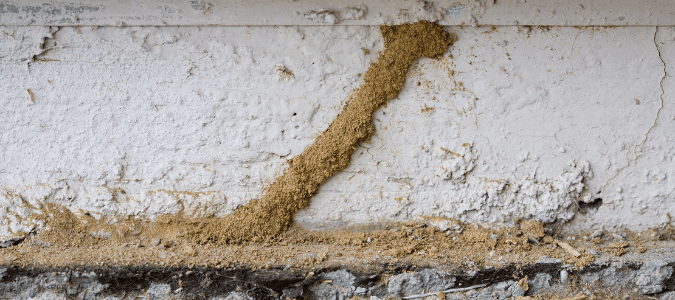Do you know the difference between an earwig and a termite? These two pests are often mistaken for each other, but they are extremely different in appearance and habits.
As a homeowner, it’s valuable to tell these insects apart so that you know what to do when you spot one of them in or around your home. While earwigs can become an annoyance, they do not pose the same threat to your home’s structure as termites.
If you spot termites or some signs of termites, it’s wise to contact a pest control professional. The faster you catch an infestation, the less damage it can do to your home. This guide will also break down two common signs of termites in your home: termites coming out of walls and termite tunnels on walls.
Earwig Appearance and Habits
Earwigs and termites may look similar to an untrained eye; however, they have quite a few physical distinctions. For starters, earwig bodies are longer than termite bodies. Most earwigs measure about half an inch to just over an inch long.
Earwigs have hard exoskeletons and dark bodies that are a reddish-brown color. They have six legs and two antennae, and their bodies are segmented into three sections. Like other arthropods, they have pincers that they use to defend themselves or carry food.
Earwigs also have pincers that protrude from their lower abdomen. While earwigs do have small wings, they are easiest to identify by the long pincers on their abdomens.
Earwigs rarely bite or cause physical harm to humans. However, if they feel threatened, they will use their pincers to pinch the skin. The pinch may hurt, but it does not usually break the skin. To avoid a pinch, do not handle earwigs yourself.
When it comes to diet, earwigs prefer to eat plants, other insects, flowers, vegetables and rotting food.
Earwigs live for about one year. They mate during the fall and winter and hatch eggs during the spring. These pests prefer to spend their life outdoors, but they can unintentionally get inside a home.
Earwig colonies prefer wet habitats, such as fallen moist leaves, garden mulch, a damp woodpile and rotting logs. If earwigs get inside your home, they pose much less of a threat and are easier to exterminate than termites. They will likely feed on the fruits and vegetables in your kitchen.
To keep earwigs out of your home, make sure your doors and windows are secure and do not have any cracks. These pests are a bigger problem when they set up camp outside because they can harm your garden.
A few earwigs in your garden are not a problem. Earwigs can benefit your garden by eating other unwanted pests and rotting plant matter. However, a big earwig infestation can cause damage, especially if there is no decaying matter for them to eat.
Termite Appearance and Habits
Termites threaten your home more than earwigs because they can cause serious structural damage. Unlike earwigs, termite workers and soldiers have light-colored bodies. They have softer exoskeletons, and their bodies range from white to light brown.
Termites are also smaller than earwigs. Their bodies measure between a quarter and a half of an inch long. They are closer in size to ants and are more likely to get mistaken for ants than earwigs. However, unlike ant swarmers, all four wings of termite swarmers are of equal size.
Swarmer termites and worker termites are smaller than king and queen termites, and they also have shorter lifespans. Swarmer and worker termites live for one to two years while queen termites can live for up to 25 years. King and queen termites can grow to be one inch long.
Termites prefer to feast on wood, paper, leaves, grass, cotton and cardboard. These unwanted pests burrow into wood and chew away at it from the inside out. This is one reason they cause structural damage to buildings.
Termites thrive outdoors and indoors as long as they can access wet wood. On the exterior of homes, they establish themselves near the foundation and wood siding. How do termites get in your home? Termites can easily enter structures undetected through gaps in the foundation as well as around pipes that penetrate a slab.
Homeowners can spot termites all over the house. Signs of termites include spotting their discarded wings, damaged wood, mud tubes and termite frass, or droppings. It’s helpful to know how to identify termite damage versus wood rot.
If you see or suspect a termite infestation, contact a pest control expert.
What to Do About Termites Coming Out of Wall
Sometimes the first sign of a termite infestation is seeing a large group of termites flying out of your walls. These pests are swarming termites searching for a new home to set up their colony. Swarmer termites will fly out of walls in large groups to find a new place to breed and lay eggs. Seeing this is extremely unpleasant for homeowners; however, swarmer termites do not hurt humans.
If you see swarmer termites inside your home, you already have an infestation, which will only grow as the termites breed.
One positive thing about seeing swarmer termites coming out of your walls is that you can identify where they are coming from. However, the first step is to get rid of the swarmer termites. One way to do this is to vacuum them up while they are swarming. After the swarm, you will spot dead bodies and discarded wings that you can also vacuum up. When you finish, throw the vacuum bag away.
This method will help prevent multiple termite colonies from nesting on your property, but it won’t do anything to control the current termite population. For long-term relief, contact a pest control expert for termite control. They will use professional methods that will get rid of termites and prevent them from coming back again.
What to Do About Termite Tunnels on Wall
Worker termites build tunnels that their colonies can use to move throughout your walls and the foundation of your home. The tunnels, also known as mud tubes, protect termites from predators and lock in the moisture needed to survive.
It’s common to spot these tunnels before seeing termites, so it’s helpful to know what they look like. Worker tunnels are the color and shape of a pencil. In diameter, they measure between a quarter inch and one inch.
The way that worker termites build tunnels along walls, window sills and foundations resembles a complex highway system. They are several lanes for the termite colony to travel through, and they each serve a purpose. For example, they use one lane to carry food back to the nest while another lane is used for tunnel repairs.
Homeowners also find worker termite tunnels under porches, on window frames, joists and subfloors.
If you see termite tunnels or mud tubes anywhere in your home, contact a pest control service. These tunnels indicate that a termite colony has taken up residence in your home.
A termite infestation can cause costly damage. Whether you see swarmer termites coming out of walls, termite tunnels on walls or other common signs of an infestation, it’s important to act.
Do not try to get rid of termites on your own. Contact a pest control expert to control the infestation and prevent termites from returning.
ABC Can Treat the Termites on Your Property
Finding termites on your property can be extremely frightening. These pests are destructive and their colonies can hold thousands of members. If you believe you have termites on your property, contact ABC Home & Commercial Services. Our professionals will be able to locate the termite colony and then implement an effective pest control plan.




